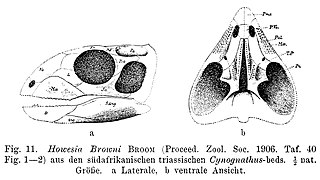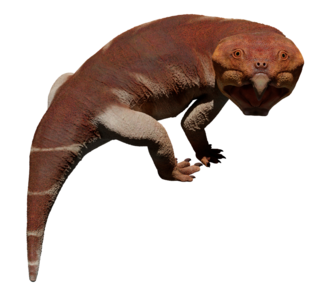
Archosauromorpha is a clade of diapsid reptiles containing all reptiles more closely related to archosaurs rather than lepidosaurs. Archosauromorphs first appeared during the late Middle Permian or Late Permian, though they became much more common and diverse during the Triassic period.

Michael James Benton is a British palaeontologist, and professor of vertebrate palaeontology in the School of Earth Sciences at the University of Bristol. His published work has mostly concentrated on the evolution of Triassic reptiles but he has also worked on extinction events and faunal changes in the fossil record.

Rhynchosaurs are a group of extinct herbivorous Triassic archosauromorph reptiles, belonging to the order Rhynchosauria. Members of the group are distinguished by their triangular skulls and elongated, beak like premaxillary bones. Rhynchosaurs first appeared in the Early Triassic, reaching their broadest abundance and a global distribution during the Carnian stage of the Late Triassic.

Trilophosaurs are lizard-like Triassic allokotosaur reptiles related to the archosaurs. The best known genus is Trilophosaurus, a herbivore up to 2.5 metres long. It had a short, unusually heavily built skull, equipped with massive, broad flattened cheek teeth with sharp shearing surfaces for cutting up tough plant material. Teeth are absent from the premaxilla and front of the lower jaw, which in life were probably equipped with a horny beak.

Hyperodapedon is an extinct genus of rhynchosaur reptiles which lived during Late Triassic period. Like other rhynchosaurs, it was an heavily built archosauromorph, distantly related to archosaurs such as crocodilians and dinosaurs. Hyperodapedon in particular was part of the subfamily Hyperodapedontinae, a specialized rhynchosaurian subgroup with broad skulls, beaked snouts, and crushing tooth plates on the roof of the mouth.

Batrachotomus is a genus of prehistoric archosaur. Fossils of this animal have been found in southern Germany and dated from the Ladinian stage of the Middle Triassic period, around 242 to 237 million years ago. Batrachotomus was described by palaeontologist David J. Gower 22 years after its discovery.

Clevosaurus is an extinct genus of rhynchocephalian reptile from the Late Triassic and the Early Jurassic periods. Species of Clevosaurus were widespread across Pangaea, and have been found on all continents except Australia and Antarctica. Five species of Clevosaurus have been found in ancient fissure fill deposits in south-west England and Wales, alongside other sphenodontians, early mammals and dinosaurs. In regards to its Pangaean distribution, C. hadroprodon is the oldest record of a sphenodontian from Gondwana, though its affinity to Clevosaurus has been questioned.

Tetragonias is an extinct genus of dicynodont from the Anisian Manda Beds of Tanzania. With tetra meaning “four,” and goni meaning “angle,” the name references the square shape of the Tetragonias skull when viewed dorsally. Not to be confused with the plant Tetragonia,Tetragonias were dicynodont anomodonts discovered in the late 1960s by paleontologist A. R. I. Cruickshank in the Manda Formation. Only the type species, T. njalilus, has been recognized.

Sanjuansaurus is a genus of herrerasaurid dinosaur from the Late Triassic (Carnian) Ischigualasto Formation of the Ischigualasto-Villa Unión Basin in northwestern Argentina.

Bentonyx is an extinct genus of rhynchosaur from the middle Triassic epoch of Devon in England. Its fossil, a well preserved skull, BRSUG 27200, was discovered in Otter Sandstone Formation and was first assigned to Rhynchosaurus spenceri, that is known from 25 specimens. This species was reassigned to its own genus, Fodonyx, that was first described by David W. E. Hone and Michael Benton in 2008. More recently, this skull was reassigned to this genus by Max C. Langer, Felipe C. Montefeltro, David E. Hone, Robin Whatley and Cesar L. Schultz in 2010 and the type species is Bentonyx sidensis.

Fodonyx is an extinct genus of rhynchosaur from the middle Triassic epoch of Devon in England. Its fossils were discovered in Otter Sandstone Formation and were first assigned to Rhynchosaurus spenceri. This species was reassigned to its own genus, Fodonyx the holotype of which is EXEMS 60/1985/292, that described by David W. E. Hone and Michael J. Benton in 2008. More recently, one skull was reassigned to the new genus Bentonyx. It is distinguished from other rhynchosaurs by a single autapomorphy, the ventral angling of the paraoccipital processes. In all other rhynchosaurs these processes angle dorsally or are horizontal. It is not known if this conferred any advantage to Fodonyx. Fodonyx was between 40 and 50 cm long.

Stenaulorhynchus is an extinct genus of hyperodapedontid rhynchosaur known from the Middle Triassic deposits of Tanganyika Territory, Tanzania. It was found in the Lifua Member of the Manda Formation in the Karoo Supergroup. It was named and first described by Sidney Henry Haughton in 1932. The type species is Stenaulorhynchus stockleyi, a beaked herbivore measuring 1–6 meters in length.

Howesia is an extinct genus of basal rhynchosaur from early Middle Triassic deposits of Eastern Cape, South Africa. It is known from the holotype SAM 5884, a partial skeleton with palate and partial lower jaws and from two paratypes, SAM 5885 and SAM 5886. It was found in the Burgersdorp Formation of the middle deposits of the Beaufort Group and referred to Subzone B of the Cynognathus Assemblage Zone. It was first named by Robert Broom in 1905 and the type species is Howesia browni, named after Alfred Brown.
Supradapedon is an extinct genus of hyperodapedontine rhynchosaur from mid-late Triassic deposits of Tanganyika Territory, Tanzania. It is known from the holotype SAM-11704. The holotype and only specimen of Supradapedon was first assigned to a species of Scaphonyx, Scaphonyx stockleyi. This species was reassigned to its own genus by Sankar Chatterjee in 1980 and the type species is Supradapedon stockleyi. One study, Langer et al. (2000), concluded that Supradapedon is a synonym of Hyperodapedon and referred it to Hyperodapedon sp. However, the provisional validity of this genus has been commonly accepted since.

Hyperodapedontinae is a subfamily of rhynchosaurs within the family Rhynchosauridae. Fossils have been found from Argentina, Brazil, Canada, India, Madagascar, Scotland, Tanzania, United States and Zimbabwe.
Otischalkia is an extinct genus of archosauromoph from late Triassic deposits of Howard County, Texas, US It is known from the holotype TMM 31025-263, left humerus and from the referred specimens TMM 31025-262, TMM 31025-266, TMM 31025-264, TMM 31185-92 and TMM 31185-93. It was found in the Lower Dockum Group near the abandoned settlement of Otis Chalk. It was first named by Adrian P. Hunt and Spencer G. Lucas in 1991 and the type species is Otischalkia elderae.

Protorosauria is an extinct, likely paraphyletic group of basal archosauromorph reptiles from the latest Middle Permian to the end of the Late Triassic of Asia, Europe and North America. It was named by the English anatomist and paleontologist Thomas Henry Huxley in 1871 as an order, originally to solely contain Protorosaurus. Other names which were once considered equivalent to Protorosauria include Prolacertiformes and Prolacertilia.

Noteosuchus is an extinct genus of basal rhynchosaur known from the earliest Triassic deposits of Eastern Cape Province, South Africa. It was first named by David Meredith Seares Watson in 1912 and the type species is Eosuchus colletti. The generic name Eosuchus is preoccupied by the generic name of Eosuchus lerichei Dollo, 1907, a gavialoid crocodilian known from northern France. Thus, an alternative generic name, Noteosuchus, was proposed by Robert Broom in 1925. The generic name erected by Broom (1925) is a compound, meaning "Not Eosuchus", while "Eosuchus" is derived from the name of Eos, the goddess of the dawn in Greek mythology, and suchus, Latinized from the Greek souchos, an Egyptian crocodile god, thus meaning "dawn crocodile". The specific name, colletti, honors Mr. Collett for the discovery of the holotype and only known specimen.
Langeronyx is an extinct genus of basal rhynchosaurid known from the early Middle Triassic Bromsgrove Sandstone Formation of Warwickshire, UK. It contains a single species, Langeronyx brodiei, originally included in the genus Rhynchosaurus. R. brodiei was first described and named by Michael Benton in 1990, but its redescription by Martín D. Ezcurra, Felipe Montefeltro and Richard J. Butler in 2016 recovered it as more closely related to the more advance hyperodapedontine than to the type species of Rhynchosaurus and thus it was moved to its own genus. The generic name Langeronyx honors the Brazilian paleontologist Max Cardoso Langer in recognition of his rhynchosaur research, combined with the Greek onyx (óνυξ) meaning "claw", a common suffix for rhynchosaur genera. L. brodiei is known solely from the holotype, a partial skull divided into the two specimens WARMS G6097/1 and NHMUK PV R8495, housed in the Warwickshire Museum, Warwick and Natural History Museum, London, respectively. Other specimens originally referred to R. brodiei either do not overlap with its type or can be just as likely referred to other basal rhynchosaurids. L. brodiei is one of two basal archosauromorphs known from the Bromsgrove Sandstone Formation, the other being the lesser known Rhombopholis scutulata.
Oryctorhynchus is an extinct genus of rhynchosaur from the Late Triassic (Carnian-Norian)-aged Wolfville Formation of Nova Scotia, Canada that may have been the same animal as Beesiiwo. The type species, O. bairdi, was named and described in 2020. It was originally seen as a species of Hyperodapedon until 2020.

















